Tibet is more than sweeping plateaus and snow-capped peaks – it is a living, flowering landscape. Despite thin air, intense ultraviolet light and a harsh climate, Tibet hosts an astonishing variety of alpine plants: more than six thousand species thrive across ridge, scree and meadow. In spring and autumn the highlands transform into a vast garden where carpets of flowers, dramatic single-stalk wonders and fragile blue poppies paint the landscape with color and meaning.
Tibet’s high-alpine environment and why flowers thrive here
Tibet’s extreme environment — strong sunlight at low latitudes, cold nights, large diurnal temperature swings and microclimate variation — creates the unique conditions that alpine plants exploit. Many species grow close to the snow line; some bloom in gravelly scree or thin alpine soil; others form dense cushions to resist wind and frost. The adaptations these plants display (compact forms, hairy leaves, deep root systems) are reasons they can survive where other plants cannot. For visitors, that means flowers appear in unexpected places: on wind-scoured ridges, beside glacial streams, and in sheltered hollows where meltwater and sunlight combine.

When to go: best seasons to see Tibetan flowers
The alpine flowering season varies by altitude and region, but generally:
- Late spring to early summer (May–June): Lower alpine and montane zones start to bloom. Rhododendrons and early meconopsis appear at mid-altitudes.
- High summer (July–August): Peak flowering in many high meadows; cushion plants and gentians are vivid.
- Early autumn (September): Some species have a second flourish; late-season light gives color a golden cast.
Plan your trip based on the elevation you intend to visit: higher elevations bloom later and for shorter windows. Always factor in weather variability and allow extra days for flexibility.
Top 10 Tibetan wildflowers
Below are ten of the most eye-catching and travel-friendly plants you will encounter across Tibet’s alpine tapestry. Each description includes a travel-focused note on where you’re most likely to see them.
Galsang Flower (Asters and Cultivated Asters)
Galsang is celebrated in Lhasa as a local emblem: its name in Tibetan means “good times,” and it is often thought of as a flower of happiness. Locals use “Galsang” as a catch-all for hardy plateau asters — from wild species to cultivated garden asters found between Qamdo and Lhasa. The blossoms range from simple single daisies to fuller cultivated varieties; they thrive in meadows and roadside gardens alike.
Where to see: Urban gardens in Lhasa and lower valley meadows during spring and early summer. For photographers, Galsang adds a cheerful foreground to monastery walls and yak pastures.

Galsang Flower
Rhododendron (Rhododendron lapponicum and relatives)
Tibet is rich in rhododendrons — nearly two hundred species occupy forest margins, alpine scrub and high meadows between roughly 3,000 and 5,500 metres. Their flowers arrive in clusters, often forming ball-like displays in hues from white and pink to deep magenta and yellow. In late spring to early summer, rhododendron slopes in Nyingchi, Bomi and other southeastern valleys create spectacular floral carpets.
Where to see: Southeastern Tibet (Nyingchi, Bomi, Milin), foothill regions near Yadong and Nyela. Ideal during full bloom, mid-April to June depending on altitude.
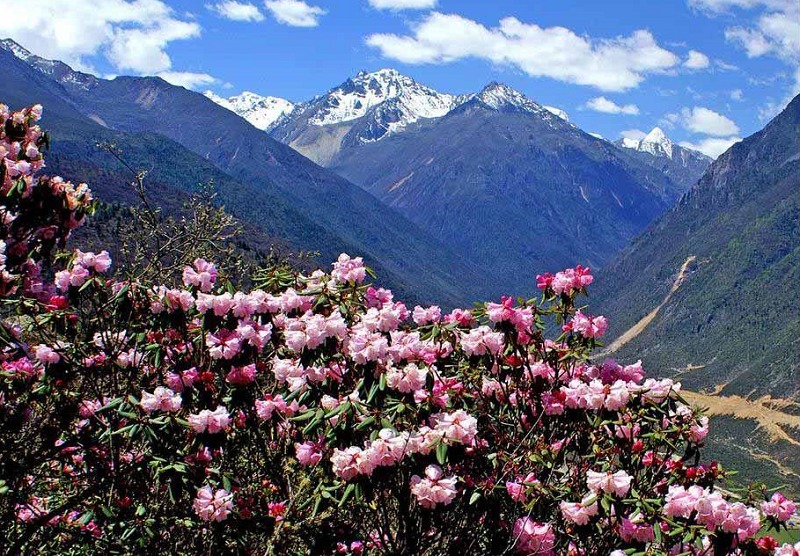
Rhododendron
Meconopsis (Himalayan Blue Poppy)
Meconopsis — the famous Himalayan blue poppy — is one of the world’s quintessential high-alpine icons. Delicate yet robust, its sky-blue blossoms seem almost unreal against a backdrop of grey scree or green meadow. Many species of meconopsis grow near the snowline between about 3,900 and 5,000 metres. Garden lovers in Europe once coveted these “blue poppies,” and seeing them in the wild is a rare and moving experience.
Where to see: High meadows and scree slopes in alpine zones; look for them in eastern Himalayan valleys and sheltered high pastures during summer.

Meconopsis
Snow Lotus (Saussurea involucrata)
Snow lotus grows above 3,000 metres on snow-touched slopes. Its layered, woolly bracts form a compact head reminiscent of a lotus; the flowers are small, purple-tinged and tightly clustered. Highly prized in Tibetan culture for its symbolism and medicinal associations, snow lotus thrives in cold, dry air and can bloom amid icy conditions. It is a symbol of endurance and purity.
Where to see: High alpine slopes and rocky ledges above 3,000 metres. Snow lotus is often scarce and localized, so sightings are special and best appreciated from a respectful distance.

Snow Lotus
Incarvillea younghusbandii
Incarvillea younghusbandii is a hearty alpine with tubular flowers that range from purple to pale pink and sometimes show an orange-yellow throat. It grows in sandy meadows and gravelly hillsides at high altitude, where the showy blooms appear surprisingly bright against a bare landscape. This species is ornamental and photogenic, especially when catching afternoon light.
Where to see: Scattered across high pastures of Qinghai and Tibet (Lhasa, Nagqu, Tingri and other zones). Blooming peaks in summer months.
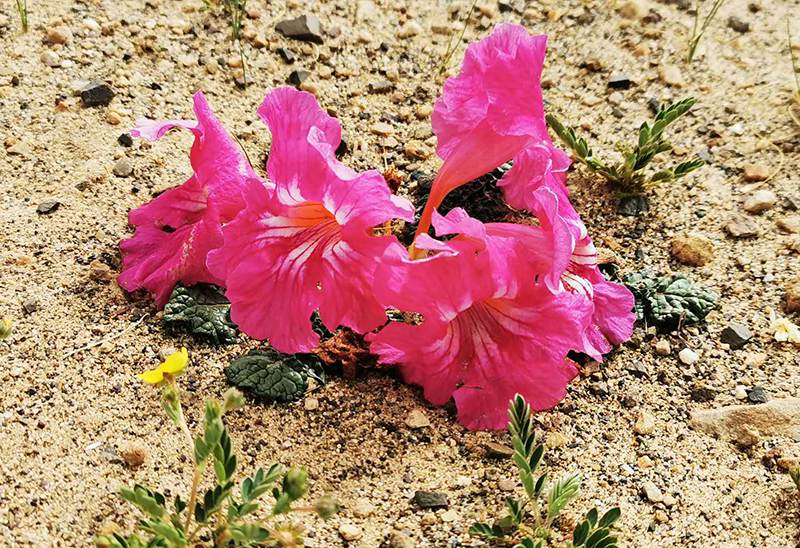
Incarvillea younghusbandii
Gentiana veitchiorum (Gentians)
Gentians are prized for their vivid blue and deep azure trumpets. Gentiana veitchiorum displays striped or spotted patterns with a mix of yellow-green and blue — a striking contrast that catches the eye. These perennial herbs grow between roughly 2,500 and 4,800 metres in grassland and woodland edges, and their intense color makes them a magnet for macro photography.
Where to see: Central and eastern Tibetan woodside grasslands and alpine meadows; summer bloom season.
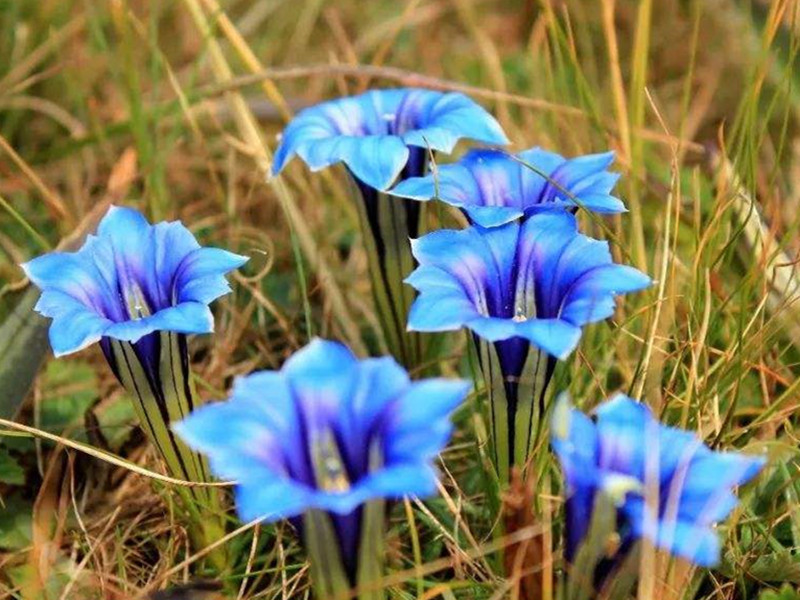
Gentiana veitchiorum
Stellera chamaejasme
Stellera chamaejasme is a humble but widespread perennial herb with oblong leaves and small clustered flowers. It is notable for its strong root system and exceptional resilience to arid, cold conditions. The plant contains toxic compounds and has a long history of use in traditional remedies (externally) — but it should never be ingested by humans or livestock.
Where to see: Common across the Qinghai-Tibet Plateau and loess regions; open meadows and degraded grassland areas.

Stellera chamaejasme
Rheum nobile (The Giant Alpine Herb)
Rheum nobile is dramatic: a cabbage-like rosette for years, then a single towering inflorescence that may reach one to two meters in its flowering year. The stalk becomes a magnificent pagoda of flowers and bracts before the plant dies back — a once-in-a-lifetime floral spectacle. It grows in rocky alpine beaches and wet grasslands around 3,900–4,000 metres.
Where to see: Himalayan alpine belts in Tibet and northwestern Yunnan; best seen in peak flowering years (after several seasons of vegetative growth).

Rheum nobile
Lamiophlomis rotata (Medicinal Cushion Plant)
Lamiophlomis rotata is a low, tough perennial with a deep, thick rhizome. It occupies stony alpine meadows, river beaches and weathered gravel slopes between roughly 3,900 and 5,100 metres. Valued as a traditional medicinal herb for promoting circulation and relieving pain, it also provides modest floral displays and contributes to fragile meadow ecology.
Where to see: Scattered across alpine meadows in Tibet and adjacent provinces; summer bloom window.
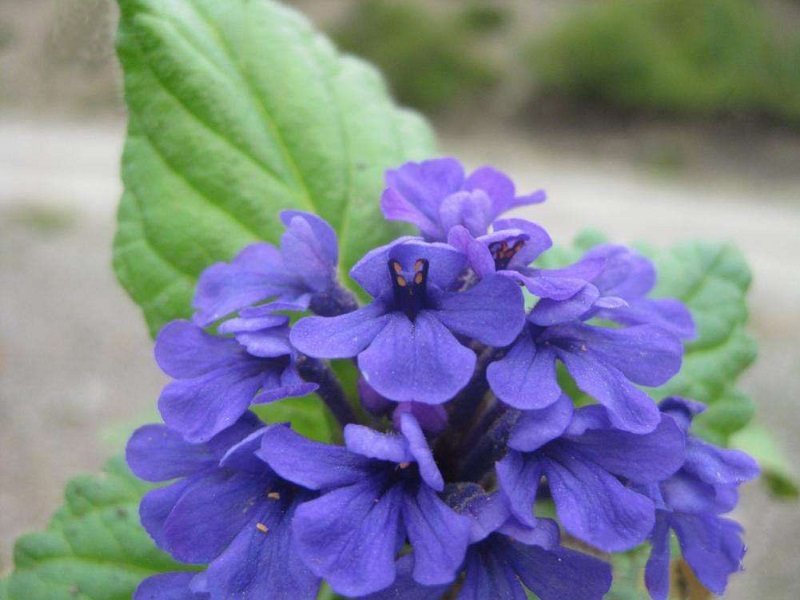
Lamiophlomis rotata
Sophora moorcroftiana (River-valley Shrub)
Sophora moorcroftiana is a small leguminous shrub that transforms valley slopes into purple-blue stretches when in bloom. It thrives between roughly 3,000 and 4,500 metres near rivers and foothills and is useful both for livestock forage and ecological restoration thanks to its sand-fixing roots. Locally called “skyi-ba,” its seeds and woody material find uses in traditional life.
Where to see: River valleys and foothill scrublands on routes like Shigatse to Lhatse; best in late spring to summer bloom season.
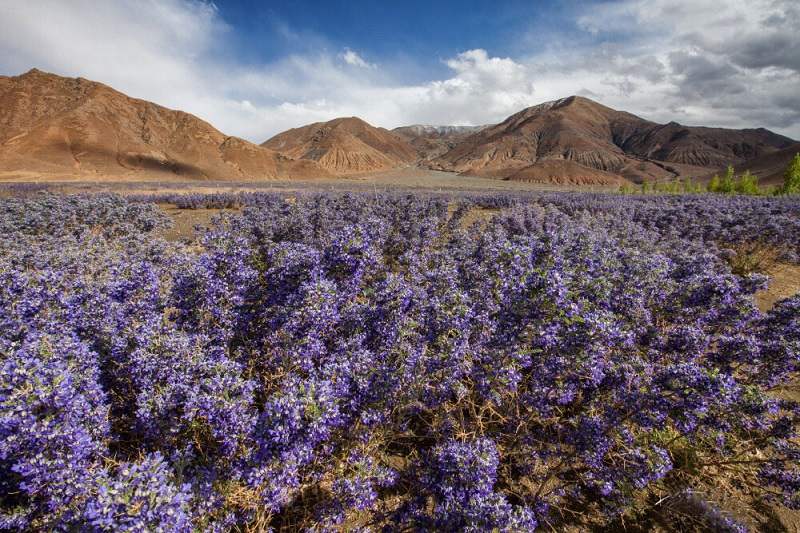
Sophora moorcroftiana
How to plan a flower-focused trip in Tibet
If your main goal is floral encounters, design an itinerary that staggers altitude and concentrates on regions known for plant diversity:
- Choose regional clusters: Southeastern Tibet (Nyingchi, Bomi) for rhododendrons and dense forest flowers; alpine meadows of central Tibet and higher pastures for meconopsis, gentians and Rheum nobile.
- Pace your ascent: Move gradually from lower valleys to higher plateaus to allow acclimatisation and to catch different altitude-dependent blooms.
- Time your visit: Aim for local peak bloom months, but factor in altitude shifts — higher flowers bloom later.
- Hire a botanical-savvy guide: A local naturalist or experienced guide will point out the exact sites and teach you how to read seasonal cues.
- Allow flexibility: Weather, grazing patterns and microclimate can alter bloom times by days or weeks; build buffer days into your plans.
Photography tips for alpine flowers
- Get low and close: Low angles emphasize flowers against sky and mountain backdrops.
- Use wide apertures for intimate portraits: A shallow depth of field isolates blooms from busy alpine backgrounds.
- Bring a macro lens or extension: For detailed shots of petals, hairs and pollen.
- Mind the light: Early morning and late afternoon deliver soft golden tones; midday sun at high altitude is harsh.
- Protect equipment: Batteries drain faster in cold; keep spares warm against your body.
Tibetan Flowers’ Cultural significance and traditional uses
Many Tibetan flowers hold cultural or medicinal meaning. Snow lotus symbolizes endurance and purity; Lamiophlomis rotata and Sophora moorcroftiana have roles in traditional medicine and daily rural life. Monasteries and local festivals often celebrate blooms in seasonal rituals, and pastoral communities incorporate wild plants into fuel, fodder and small-scale remedies. When photographing or collecting (which you should not do without permission), remember that these plants are part of living cultural landscapes.
Why Tibetan flowers are travel treasures
Tibetan flowers matter because they show life enduring in extremes — fragile, colorful testimonies to adaptation and resilience. For the international traveller, encountering these blooms is not only a visual delight but also a way into deeper conversations about climate, culture and the ecology of the high Himalaya. Observing alpine flowers responsibly connects you with place in a gentle, curious way.












